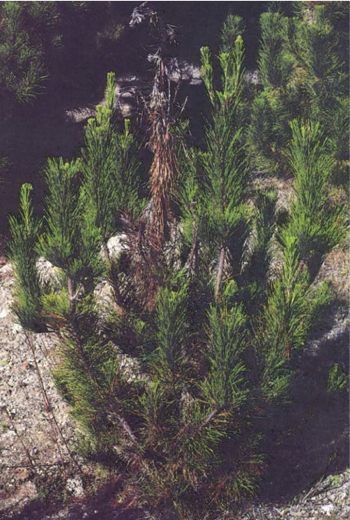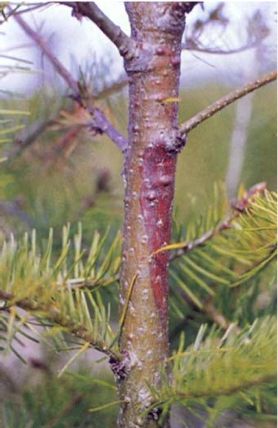PESTS AND DISEASES OF FORESTRY IN NEW ZEALAND
Allantophomopsis pseudotsugae
From Forest Pathology in New Zealand No. 13, Some minor fungi of conifers.
Based on I.A. Hood and C.J. Sandberg (1985)
Type of injury
Shoot dieback, stem girdling, and cankering in young trees following frost injury or wounding.
Diagnostic features
- Death of terminal or one or more lateral branches (Fig. 1, 2).
- Canker formation on living shoots (Fig. 3).
- Browning of foliage on diseased shoots.
- Numerous, small (less than 1 mm in diameter), black, spherical fruiting bodies partially emergent through bark on diseased shoots or present in dead needles.
- Diseased trees less than 10 years old.
- Diseased trees usually on frost-prone sites (frost hollows or flats, often typified by the presence of Dracophyllum subulatum in the central North Island).
Notes: It is difficult to separate symptoms of this disease from those caused by frost damage alone. Allantophomopsis pseudotsugae does, however, cause browning of tissues beneath the bark, and infection is not restricted to current shoot growth, whereas frost damage is frequently confined to current shoots which do not initially appear brown when bark is removed. Symptoms may also be confused with those of Diplodia pinea which causes similar damage.
Hosts
Cedrus brevifolia; Cupressus macrocarpa; Larix decidua; L. kaempferi; Pinus canariensis; P. contorta; P. muricata; P. nigra ssp. laricio; P. ponderosa; P. radiata; Pseudotsuga menziesii; Thuja plicata.
Distribution
Throughout New Zealand.

Fig. 2 - Branch dieback of young Pinus radiata caused by Allantophomopsis pseudotsugae following frost damage.

Fig. 3 - Canker in stem of Pseudotsuga menziesii induced by Allantophomopsis pseudotsugae.
Disease development
The fungus is commonly found on dead conifer branches and foliage, but can also be a wound parasite which invades living tissues after first colonising dead branches, frost-killed shoots, or frost-induced bark cracks. Infection by spores may occur either at shoot tips or lower in the stem. Growth within living tissue is limited, and infection in shoot tips does not normally grow down past the second or third internodes. Lower stem infection may lead to canker formation or, if girdling occurs, to wilting and death of the whole shoot.
Economic importance
Allantophomopsis pseudotsugae serves chiefly to aggravate the effects of frost damage and may adversely influence tree growth and form. It is not usually fatal, except on newly planted or weakened trees. This fungus caused some concern in the 1930s when plantations of exotic conifers were more commonly established in frost-prone localities and on sites at more than 600 m above sea level. Today the disease is of limited importance, occasionally appearing on sites exposed to heavy frost, particularly if windrowing has been carried out and if unsuitable planting stock is used. Allantophomopsis pseudotsugae may also damage nursery seedlings.
Control
No control is necessary beyond the usual precautions taken to avoid frost injury.

 Farm Forestry New Zealand
Farm Forestry New Zealand

